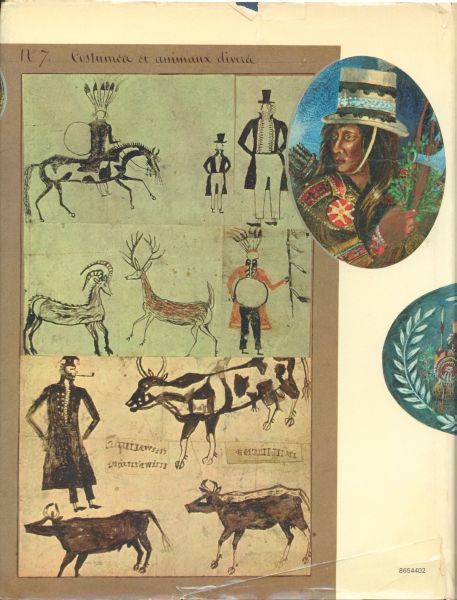


| WILDERNESS KINGDOM Indian Life in the Rocky Mountains: 1840-1847 Joseph P. Donnelly New York: Holt, Rinehart and Winston, 1967 |
Rating: 5.0 High |
|||
| LibCongNo 67-19048 | ||||
| ISBN-10 8654402 | 274pp. | HC/LF/FCI | $21.95 | |
Many must imagine, as I did, that American Indian tribes were uniformly "heathen" before forceful conversion by large numbers of Europeans (Spaniards in the southwest, northern Europeans in the east.) Like many assumptions about history, that turns out not to be the case.
|
"In about 1816 a group of Catholic Iroquois, long settled at Caughnawaga opposite Montreal, migrated westward, seeking a new home. They drifted into the Bitter Root valley [sic] in the present western Montana, where they came in contact with the Salishan Flatheads, a native race whose moral standards were surprisingly high. The immigrant Iroquois intermarried with their new friends and soon instructed them in the basic truths of Catholicism. Knowing that the Indians had need of missionaries, the Iroquois and Flatheads despatched several expeditions to St. Louis, where they knew they would find their traditional spiritual fathers, the Jesuits. After several failures, one intrepid band finally reached St. Louis in 1831, where Bishop Rosati promised to do what he could for them. – Page 6 |
When Father Nicholas Point, S.J., headed westward by wagon on 30 April 1841 to assist Father Pierre Jean de Smet in establishing the first Catholic mission in America's northwest, there was not a single permanent white settler in the remote northern Rocky Mountain region where he was bound. Many of the Indians he met there remembered the Lewis & Clark expedition of 1805-6. The whites they met after that expedition were mountain men trapping for pelts and trading manufactured goods with the Natives but not coveting their land. Father Point labored for six years to bring word of the Christian God to the tribes, establishing or helping to establish missions among the Flatheads, Coeur d'Alenes and Blackfeet in the 1840s.
As official diarist of the mission, Father Point made two records. The first was his account of the mission work he undertook and its effect on Native minds and hearts. The second was a richly detailed description of Indian life and customs as he observed them. He repeatedly joined buffalo hunts, and some of these involved intertribal warfare.
Father Point supplemented his written text with numerous miniature paintings. Again, these fall into two categories: religious and descriptive. A number of the latter kind are the only extant visual depiction of Indian figures and ceremonies. They comprise a unique testament that is of great importance to anthropologists and historians.
Joseph P. Donnelly is on the faculty of Marquette University in Milwaukee, WI. A Jesuit himself, he is a historian of Jesuit explorations in the Americas. He has translated the journals from Father Point's original French.
Little is known of Father Point's childhood in France. He was born in Rocroy on the Muese river, now an obscure village but formerly the site of important events. He showed an early artistic talent and declared a calling to the Jesuit missionary order. After he was accepted, however, political turmoil resulted in the expulsion of the order from France. Father Point was sent to Freiburg in Switzerland, then to the Jesuit College of St. Roch at San Sebastián in Spain, the anti-clerical sentiments chasing his order all the way. Finally, in 1831, came the expulsion from Spain.
Meanwhile, the Church in America was actively recruiting. Father Point was among those Jesuits welcomed. He was appointed administrator of colleges in Louisiana and St. Louis, demonstrating a talent for the job sorely needed in dealing with hostile Americans.2 But his missionary zeal caused him to be chosen by Father de Smet for the northwest outreach. He labored mightily there but when his health began failing, he asked to be recalled. After six years, his request was granted. He was sent to relatively restful posts in Canada. There he finished out his days at the cathedral in Quebec.
"Though the art critic may find Father Point's work somewhat primitive, one cannot but be attracted to the subjects which he portrayed. His scenes of Indian life captured for us a people whose whole way of life changed almost completely during the period Father Point was among them. Point's portraits of Indians have a strength and dignity which is nothing short of amazing. Thanks to Father Point, we have a pictorial record of a people and a way of life which has vanished forever." – Page 9 |
From a production standpoint, this book is excellent. Printed on heavy paper stock with a glossy finish, it reproduces the entire text of the good Father's journals and 285 of the paintings from his collection — some in black and white, but most in full color.3, 4 He was not the greatest artist, but his talent was sufficient to convey what he meant to convey. The book includes historical notes and notes on sources. Its Bibliography contains 23 entries. I regret that I cannot take the time to read the entire book; no doubt it is a gripping tale. Yet I feel qualified to rate it a keeper, not only for professional historians but for anyone interested in American history or Native American culture.

 To contact Chris Winter, send email to this address.
To contact Chris Winter, send email to this address.